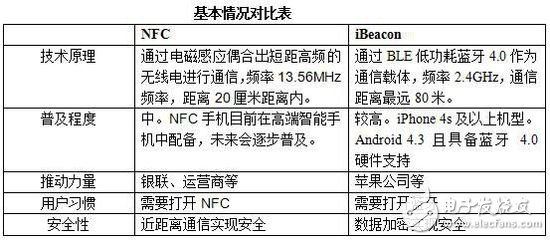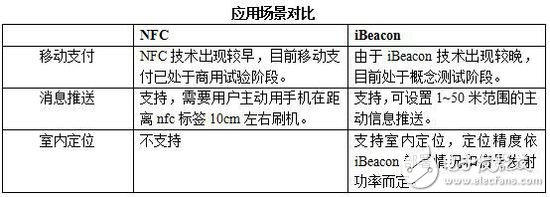NFC technology and iBeacon technology have two beautiful technologies in the fields of mobile Internet, O2O, mobile payment, scene computing and so on. These two technologies have many overlapping and similar parts, and some developers have a lot of doubts about the two technologies. This article by SENSORO chief hardware designer Zhang Qiang for you to interpret the differences between NFC technology and iBeacon technology, let everyone know more about these technologies.
Near Field CommunicaTIon (NFC) is a short-range, high-frequency radio technology that operates at a distance of 13 cm at a frequency of 13.56 MHz. The transmission speed is 106 Kbit/s, 212 Kbit/s or 424 Kbit/s. Everyone is relatively familiar with NFC technology, so what is iBeacon technology?
iBeacon technology uses Bluetooth Low Energy (also known as Bluetooth 4.0 or Bluetooth Smart) to create a signal area. When the smart phone enters the area, the iBeacon signal wakes up the user's specific APP, providing the user with specific information push, mobile payment and other services, so that the mobile device has contextual compuTIng capability.
Beacon's working principle can be divided into three simple steps:
The first step: Beacon broadcasts its own unique identification code to the mobile phone via Bluetooth;
The second step: the mobile APP sends the identification code to the cloud to obtain the scene information;
The third step: the mobile phone triggers an action.
The table below compares the basics of the two technologies.

The following table provides a preliminary comparison of the application scenarios of the two technologies.

Everyone knows more about NFC's implementation of mobile payment. How does iBeacon implement mobile payment?
One way is the standard iBeacon broadcast mode. When the consumer enters the payment Beacon coverage range (1~50 meters, the distance is adjustable), the mobile phone software can quickly find the payment object and enter the online payment process. Another way is to pay Beacon, which is usually in a silent state. When the payment is needed, the broadcast is started, and the APP in the consumer's hand is woken up. The consumer can confirm the payment on his mobile phone. In small-scale consumption places, the user experience will be greatly improved, and the time for queuing and paying for change will be reduced.
The original intention of iBeacon is to trigger a specific event indoors, but it can also be used to achieve indoor positioning. You can calculate the distance between the phone and Beacon through the relationship between RSSI and distance. It should be noted that the distance calculation formula is relatively accurate at close range. When the distance is farther, the accuracy of the calculated distance will decrease due to the multipath effect of electromagnetic waves, signal interference, and human occlusion. In addition, triangle positioning, fingerprint algorithm, etc. can be used to increase the positioning accuracy, but developers need to explore the research themselves. SENSORO will provide some open source Demo applications and APP development SDKs, which are worth learning by developers. In addition, SENSORO's "Cloud" Beacon, which combines light, temperature and motion sensors, is available.
In general, NFC technology is more mature and mature in the mobile payment field, and iBeacon technology appears later but more imaginative. In addition to mobile payment, there are a wide range of applications in indoor navigation, offline customer perception and behavior analysis, real-time hotspot statistics, next-generation social networks, and smart home.
Disposable Electronic Atomizer
Disposable Electronic Atomizer,Disposable Atomizer Electronic Cigarette,Disposable Electronic Atomizer Adapter,Disposable Electronic Atomizer Pen
Lensen Electronics Co., Ltd , https://www.lensenvape.com